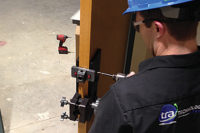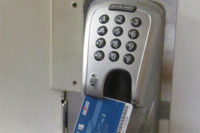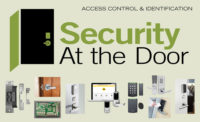

“Technology has evolved in electric strikes and magnetic locks,” says Greg Miskulin, sales engineer, Security Corp., Novi, Mich. “These products continue to be refined so the choices you have can be more specific for exactly what you need.”
Jeff Stoner, national sales manager, Eastern region, Rutherford Controls Inc., Cambridge, Ontario, Canada, says manufacturers are stressing versatility. “Manufacturers are trying to develop more versatile products that allow distributors to stock less and are more field-friendly when it comes to installation.”
Ease of installation is key, adds Kevin Klemmer, who at the time of this writing served as director of the integrated solutions specialist team for Assa Abloy, New Haven, Conn., but since has left the com pany. “We break it down into different categories for our partners. From an integrator’s perspective they want the product to work right the first time. The installers want to know that it works right in less time. And the end users want it to work every time.”
There are challenges on the horizon, too, particularly for magnetic locks. Codes are making it more costly and difficult to choose and install the right product.
“The key thing with any of these systems is economics,” says Eric White, product manager, Ingersoll Rand, Carmel, Ind. “How can we reduce the overall cost, including ease of use and time of installation, not just the product? Keeping up with codes is also a never-ending battle.”
Magnetic Locks
Code issues particularly impact magnetic locks, which have experienced a checkered past with the Authorities Having Jurisdiction (AHJ).
“One of the challenges in the magnetic lock industry is building codes and the rules around magnetic locks, which change from municipality to municipality,” Stoner says. “It seems to be up to the local AHJ, particular city or municipality. The city of Chicago has special rules that are different from the city of San Francisco. There is a lot of confusion with magnetic locks.”
This confusion may or may not be affecting sales (see related article, “Are Magnetic Locks a Niche Market?” on this page), but manufacturers are countering with more features that secure magnetic locks’ place — particularly in scenarios where only that technology makes sense, such as exit delay situations in hospitals and on retail fire doors.
“One of the things we are seeing is a surge in locks that are able to be placed in an application that makes them disappear to the traditional mounting,” says Roger Boeding, technical support technician, Securitron Magnalock, Sparks, Nev. “The big bricks at the top of the door are being replaced with sheer locks that can be mounted to a frame and be less obtrusive.”
Smaller locks are allowing magnetic locks to branch into applications that wouldn’t have been possible before, he adds. “Some of our smaller magnetic locks are specifically designed to operate as cabinet locks on electronically locked display cases and hospital drug carts.”
Some magnetic door locks use mounting rails to simplify installation as well. “The whole idea is to maximize that installer’s time in the field,” Boeding says. “The more productive you can make that crew member, the better.”
Another benefit to magnetic locks is the ability to add value onto the product with things like early warning systems that alert to a possible breach.
“Some new delayed egress magnetic locks even incorporate cameras that allow you to see who is at the door,” Stoner says.
Magnetic locks are actually well-positioned in the market, Klemmer adds. “It simply has to be addressed a lot earlier in the process. You need to make sure the AHJs are aware of how they are being deployed. But they are still an excellent security solution for storefront doors, glass doors and many other specialized applications. They are really good for convenience and great for throughput.”
Electric Strikes
On the electric strike side, products are getting simpler, smarter and more economical to install.
“Electric strikes are still very popular,” Klemmer says. “They are a great product for cost-effective access control deployment. The trend there is more integrated features, such as a built-in reader or door position monitor.
Electric strikes don’t face the same sort of code pressure that magnetic locks do, White adds. But they face competitive pressure nonetheless.
“It is really about ease of installation,” he says. “How fast can I get one of these put in? Can I minimize the modification to the door?”
To that end some manufacturers have started to offer “no-cut” strikes.
“They are very popular,” Klemmer says. “If you have the right tool it takes about three minutes to install. And even with the no cut, you still get other features like built-in door position monitoring.”
No-cut strikes benefit the installer who is not comfortable cutting the frame, Stoner adds. But he cautions they still require specialized knowledge. “There are a lot of issues around the door that can cause problems, including hinges, door warpage and alignment. If the door is out of alignment just a little bit they may not function as consistently as the traditional electric strike design.”
Though he hasn’t installed one yet, Miskulin can see the benefit of them. “This would be a handy product in office suites where the tenant doesn’t really want to cut the frame of the door because they are leasing space for a limited amount of time,” he says.
Low Power & Other Trends
One of the things that will add to the general popularity of magnetic locks and electric strikes is the trend to lower powered devices that allow them to run easily on Power over Ethernet (PoE). (See related article, “PoE Plus & Low Power Locks” on this page.) As power requirements of these devices continue to come down, more and more features will be possible on systems that use them.
“We have recently released a cabinet lock that requires very low power to operate,” Stoner says. “We believe this will be more in demand as the PoE and IP-based access control markets expand. Locks in general will likely require less power in the future.
“I really think IP access control is where things are going. In general low power will become more in demand as IP access control grows.”
As in all areas of security, another trend that will continue is more features, Klemmer adds. “You are going to see more integrated products; readers integrated into more and more of the strikes, door position sensors. There is the potential for adding CCTV cameras around electric strikes and magnetic locks. It will become much easier to get more information out of the components to say whether there is a breach or malfunction at the device. Devices will become smarter and be able to send out notices that the door is out of adjustment, for example.”
White agrees. “I don’t see it in the near future, but I do see a trend pushing more and more smarts towards the opening. We are trying to make sure we have the most monitoring and the most ability to read the current status of that opening as possible from every point around the door: the door itself, the lock, the card reader, all devices are looking to collect information and send it back to the access control system.”
Are Magnetic Locks a Niche Market?
There seems to be a discrepancy between rumor and fact when it comes to magnetic locks. But it may be that rumors of their disfavor have been exaggerated.
“Probably the most obvious trend that we are hearing about from our customers and installers is that more and more installers are moving away from magnetic locks as building codes become more strict about where they can be used,” says Jeff Stoner at Rutherford Controls Inc. “The interesting part is that while we are hearing about this trend we are not necessarily seeing that. We haven’t seen our mag lock sales decline. We haven’t seen this trend as much as people are talking about it.”
Roger Boeding at Securitron Magnalock sees it as a case of a bad rap that just needs straightening out. “Over the years magnetic locks have been misapplied and AHJs have gotten jaded because of poor installations. Sometimes they have gone to the extreme, telling contractors in select areas that they won’t accept a mag lock on the door. It’s not the product’s fault the way it was initially handled. It’s really a matter of getting fire marshals back on board to understand they are a legitimate lock.”
Some suggest that magnetic locks will continue to be strong, but in more specialized applications. “The AHJs have very strict requirements where magnetic locks can be deployed and they have fallen out of favor somewhat,” says an Assa Abloy spokesperson. “They are still an excellent solution, but you have to have buy-in from the AHJ and code compliance has got to be there.”
Boeding acknowledges that there is something to the specialization idea, but adds that sales have not indicated a downturn. “In fact we are now seeing them be used in new applications such as safe rooms in high-end houses,” he says.
“There are always going to be applications where magnetic locks are simply the best solution” notes Eric White at Ingersoll Rand. “Codes are driving some away from magnetic locks, but they are also taking into consideration that there are certain applications where nothing but a magnetic lock will really work.”
PoE Plus & Low Power Locks
One of the trends driving lower-powered locks is the increasing desire to have access control “at the edge.” Most of these devices use an end user’s existing network via Power over Ethernet (PoE). The challenge has been that many of the traditionally used locking devices used too much power to be effective in this type of system. But a new spec was recently ratified, PoE Plus, which may change the mix.
“PoE Plus provides additional current draw to the standard,” explains Kevin Klemmer, who represented Assa Abloy at the time of this writing but since has left the company. “We will definitely see more and more products that can actually be deployed. Electric strikes and mag locks are already pretty much there, but electrified locking hardware and exit devices will be added to that list.”
Eric White at Ingersoll Rand, agrees. “Right now the chief barrier is current draw,” he says. “But with PoE Plus being ratified, it may bring some new opportunities. It may still be a challenge for some of these devices, however.”
It’s a challenge that is likely to be overcome. “I expect PoE to be more and more of a factor in the future,” says Roger Boeding at Securitron Magnalock. “The ability to have an online access control system is driving it, not only PoE, but also controls using Internet-connected controllers.”


